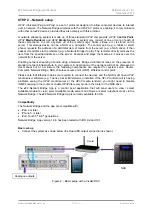
dCS
Network Bridge User Manual
Software Issue 1.0x
December 2016
Network Bridge Manual v1_0x
Page 8
English
version
STEP 1 – Connecting an output
Choose one or more of the following sections:
Connecting the Dual AES Output
The Dual AES interface is most commonly used as it is the output with the highest sample rate
capability.
•
Check that your DAC is capable of Dual AES operation and is set up correctly.
•
Connect the Network Bridge’s
AES1
output to the DAC’s AES1 input and the Network Bridge’s
AES2
output to the DAC’s AES2 input, using two XLR cables. Ensure the cables are not swapped.
•
Check that the DAC’s Dual AES setting is Auto (or On).
•
Select the DAC’s Dual AES input.
•
Note that the Network Bridge app’s
AES Downsampling
,
DSD Downsampling
and
Dual AES
Sample Rate
settings must be set to suit the DAC’s capabilities – see
Step 3
.
Connecting a Single AES or SPDIF output
•
Connect the Network Bridge’s
AES1
,
AES2
or
SPDIF
output to the matching input on the DAC rear
panel using a suitable cable.
•
Set the DAC to the input you connected.
•
Note that the Network Bridge app’s
AES Downsampling
,
SPDIF Downsampling
and
DSD
Downsampling
features must be set to suit your DAC – see
Step 3
.
Connecting the SDIF-2 interface
Check that your DAC is capable of SDIF-2 PCM or DSD operation. This interface can output up to
96kS/s or DSD/64.
!
SDIF (
S
ony
D
igital
I
nter
F
ace) is not the same as SPDIF (
S
ony/
P
hilips
D
igital
I
nter
F
ace)
and the two are not compatible.
Please ensure that you connect to the correct BNC sockets.
•
Connect the Network Bridge’s
SDIF-2 CH1
output to the DAC’s CH1 input and the Network
Bridge’s
CH2
output to the DAC’s CH2 input, using two BNC cables.
•
Connect the Network Bridge’s
SDIF-2 Out
(actually Word Clock out) to the DAC’s Word Clock
Input.
•
Ensure the cables are not swapped.
•
Set the DAC to the SDIF-2 input.
•
If necessary, set the DAC’s Sync Mode to lock to its Word Clock Input
.
•
Note that the Network Bridge app’s
DSD Downsampling
feature must be set to
On
if your DAC
cannot process SDIF-DSD/64 – see
Step 3
.
.























